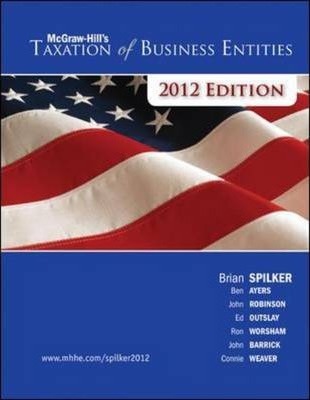
McGraw-Hill's Taxation of Business Entities 3rd Edition by Connie Weaver, Brian Spilker, Edmund Outslay, John Robinson, Ronald Worsham, Benjamin Ayers, John Barrick
Edition 3ISBN: 9780077924522
McGraw-Hill's Taxation of Business Entities 3rd Edition by Connie Weaver, Brian Spilker, Edmund Outslay, John Robinson, Ronald Worsham, Benjamin Ayers, John Barrick
Edition 3ISBN: 9780077924522 Exercise 18
Flintstone Company is owned equally by Fred Stone and his sister Wilma, each of whom hold 1,000 shares in the company. Wilma wants to reduce her ownership in the company, and it was decided that the company will redeem 250 of her shares for $25,000 per share on December 31, 2011.Wilma's income tax basis in each share is $5,000. Flintstone has current E P of $10,000,000 and accumulated E P of $50,000,000.
a. What is the amount and character (capital gain or dividend) recognized by Wilma as a result of the stock redemption, assuming only the "substantially disproportionate with respect to the shareholder" test is applied
b. Given your answer to question a, what is Wilma's income tax basis in the remaining 750 shares she owns in the company
c. Assuming the company did not make any dividend distributions during 2011, by what amount does Flintstone reduce its E P as a result of the redemption
d. What other argument might Wilma make to treat the redemption as an exchange
a. What is the amount and character (capital gain or dividend) recognized by Wilma as a result of the stock redemption, assuming only the "substantially disproportionate with respect to the shareholder" test is applied
b. Given your answer to question a, what is Wilma's income tax basis in the remaining 750 shares she owns in the company
c. Assuming the company did not make any dividend distributions during 2011, by what amount does Flintstone reduce its E P as a result of the redemption
d. What other argument might Wilma make to treat the redemption as an exchange
Explanation
Stock redemptions
Companies buy back th...
McGraw-Hill's Taxation of Business Entities 3rd Edition by Connie Weaver, Brian Spilker, Edmund Outslay, John Robinson, Ronald Worsham, Benjamin Ayers, John Barrick
Why don’t you like this exercise?
Other Minimum 8 character and maximum 255 character
Character 255


